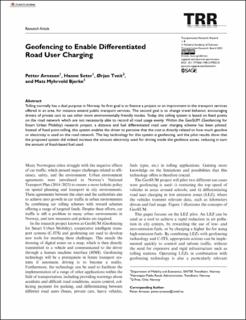| dc.description.abstract | Tolling normally has a dual purpose in Norway. Its first goal is to finance a project or an improvment in the transport services offered in an area, for instance extend public transport services. The second goal is to change travel behavior, encouraging drivers of private cars to use other more environmentally friendly modes. Today, this tolling system is based on fixed points on the road network which are not necessarily able to record all road usage evenly. Within the GeoSUM (Geofencing for Smart Urban Mobility) research project, a distance and fuel differentiated road user charging scheme has been piloted. Instead of fixed point tolling, this system enables the driver to perceive that the cost is directly related to how much gasoline or electricity is used on the road network. The key technology for this system is geofencing, and the pilot results show that the proposed system did indeed increase the amount electricity used for driving inside the geofence zones, reducing in turn the amount of fossil-based fuel used.
Many Norwegian cities struggle with the negative effects of car traffic, which present major challenges related to efficiency, safety, and the environment. Urban environment agreements were introduced in Norway’s National Transport Plan (2014–2023) to ensure a more holistic policy on spatial planning and transport in city environments. These agreements between the cities and the authorities aim to achieve zero growth in car traffic in urban environments by combining car tolling schemes with reward schemes offering a range of targeted funds. Despite these efforts, car traffic is still a problem in many urban environments in Norway, and new measures and policies are required.
In the research project known as GeoSUM (Geofencing for Smart Urban Mobility), cooperative intelligent transport systems (C-ITS) and geofencing are used to develop new tools for meeting these challenges. This entails the drawing of digital zones on a map, which is then directly transmitted to a vehicle and communicated to the driver through a human machine interface (HMI). Geofencing technology will be a prerequisite in future transport systems if automatic driving is to become a reality. Furthermore, the technology can be used to facilitate the implementation of a range of other applications within the field of transportation, including providing warnings about accidents and difficult road conditions, access control, collecting payment for parking, and differentiating between different road users (buses, private cars, heavy vehicles, fuels types, etc.) in tolling applications. Gaining more knowledge on the limitations and possibilities that this technology offers is therefore crucial.
The GeoSUM project will pilot two different use-cases were geofencing is used: i) restricting the top speed of vehicles in areas around schools; and ii) differentiating road user charging in low emission zones (LEZ), where the vehicles transmit relevant data, such as kilometers driven and fuel usage. Figure 1 illustrates the concepts of GeoSUM.
This paper focuses on the LEZ pilot. An LEZ can be used as a tool to achieve a rapid reduction in air pollution in city centers, by rewarding the use of low- and zero-emission fuels, or by charging a higher fee for using high-emission fuels. By combining LEZs with geofencing technology and C-ITS, appropriate actions can be implemented quickly to control and inform traffic, without the need for expensive and rigid infrastructure such as tolling stations. Operating LEZs in combination with geofencing technology is also a particularly relevant topic from a policy point of view because one can easily implement various restrictions, for instance based on air quality indicators, where vehicles producing more pollution (typically older vehicles) pay higher fees or are prohibited from entering certain areas.
In the GeoSUM pilot of LEZs, plug-in electric hybrid vehicles (PEHV) are of particular interest since drivers of these vehicles can choose whether to run on electric mode within an LEZ; in the future, the vehicle might even be mandated to run on electricity and thereby also be charged a lower fee. In addition, PEHVs are exempt from paying various fixed fees in the Norwegian charging system. These cars are therefore relatively cheaper than cars with petrol or diesel engines and are thereby one of the best-selling vehicle types in Norway (1), making Norway a perfect test area for this study.
The GeoSUM project is a collaboration between the Norwegian Public Roads Administration (NPRA), the private partners Volvo and Q-Free, with the Norwegian University of Science and Technology (NTNU) and the research organization, SINTEF, as research partners (2). | |

